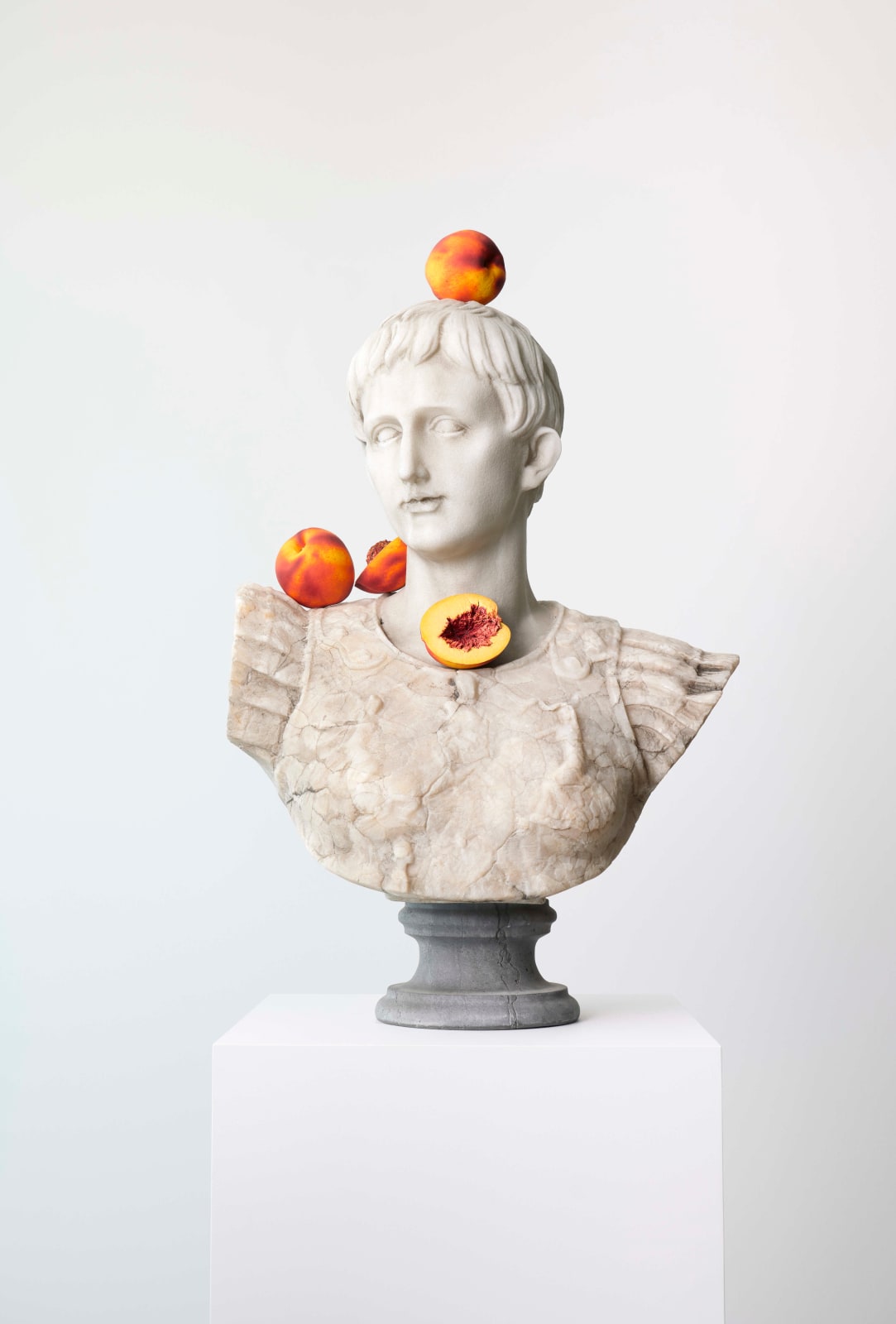

Tony Matelli United States, b. 1971
Bust (Nectarines), 2022
marble and painted bronze
unique
unique
76.2 x 45.7 x 30.5 cm
30 x 18 x 12 in
30 x 18 x 12 in
Copyright of Tony Matelli Studio
Born in 1971 in Chicago, Tony Matelli is a New York-based sculptor known for his painstakingly detailed, resemblant sculptures. Concerned with how we define ourselves as human beings, what constitutes...
Born in 1971 in Chicago, Tony Matelli is a New York-based sculptor known for his painstakingly detailed, resemblant sculptures. Concerned with how we define ourselves as human beings, what constitutes meaningful relationships, and the transience of life, Matelli chronicles these ideas through a playful lens whilst pushing the boundaries of his medium. The result is a subversive dialogue that deepens the conversation surrounding the possibilities of sculpture. Incorporating figurative, botanical, and abstract forms, his bronze sculptures rely on unusual juxtapositions such as his weeds series in which plants sprout from the space between gallery walls and floors. Across his oeuvre, and particularly in his mirror paintings, Matelli discards traditional genre categories in favor of experiential concerns. His work has been extensively exhibited in notable institutions including the National Gallery of Victoria, Melbourne, Uppsala Museum, Sweden, Palais de Tokyo, Paris, The Davis Museum, Wellesley, MA, Kunsthalle, Vienna, and Bergen Kunstmuseum, Norway. His sculpture, Sleepwalker, is one his most iconic works and has been prominently featured at The High Line in New York and the campus of Wellesley College in Massachusetts.
The work comes from The Garden Sculptures series which began in 2014 with a spontaneous gesture. Matelli was carrying a bag of groceries to his Brooklyn home when he passed a burnt-out taxi. Without thinking, he placed a strawberry on it. He liked the pop of the fresh, red fruit on the charred metal, both as image and idea. He began to investigate the juxtaposition’s artistic potential, experimenting with broken washing machines and discarded machinery as settings for fruits, vegetables, and other comestibles that he would meticulously reproduce in painted bronze and cast silicone, even going so far as to include colored glass elements to simulate translucent citrus fruit. Eventually, he settled on cement and marble reproductions of ancient Greek and Roman, Chinese, and Renaissance sculptures purchased from garden stores and makers of cemetery monuments. Matelli’s decision to merge perishable food and durable sculpture was intuitive. They were interesting opposites, and he liked the way the stone figures’ pale colors offset the colorful foodstuffs as well as the pairing’s implied collisions of hard and soft, permanent and perishable.
The sculpture depicts Claudius Tiberius Claudius Caesar Augustus Germanicus the fourth Roman emperor, ruling from AD 41 to 54.
The work comes from The Garden Sculptures series which began in 2014 with a spontaneous gesture. Matelli was carrying a bag of groceries to his Brooklyn home when he passed a burnt-out taxi. Without thinking, he placed a strawberry on it. He liked the pop of the fresh, red fruit on the charred metal, both as image and idea. He began to investigate the juxtaposition’s artistic potential, experimenting with broken washing machines and discarded machinery as settings for fruits, vegetables, and other comestibles that he would meticulously reproduce in painted bronze and cast silicone, even going so far as to include colored glass elements to simulate translucent citrus fruit. Eventually, he settled on cement and marble reproductions of ancient Greek and Roman, Chinese, and Renaissance sculptures purchased from garden stores and makers of cemetery monuments. Matelli’s decision to merge perishable food and durable sculpture was intuitive. They were interesting opposites, and he liked the way the stone figures’ pale colors offset the colorful foodstuffs as well as the pairing’s implied collisions of hard and soft, permanent and perishable.
The sculpture depicts Claudius Tiberius Claudius Caesar Augustus Germanicus the fourth Roman emperor, ruling from AD 41 to 54.
Provenance
Artist StudioExhibitions
Tony Matelli: Timelines, MARUANI MERCIER Gallery, 2023, Brussels (cat.)Join our mailing list
* denotes required fields
In order to respond to your enquiry, we will process the personal data you have supplied to communicate with you in accordance with our Privacy Policy. You can unsubscribe or change your preferences at any time by clicking the link in our emails. This site is protected by reCAPTCHA and the Google: Privacy Policy and Terms of Service apply.

